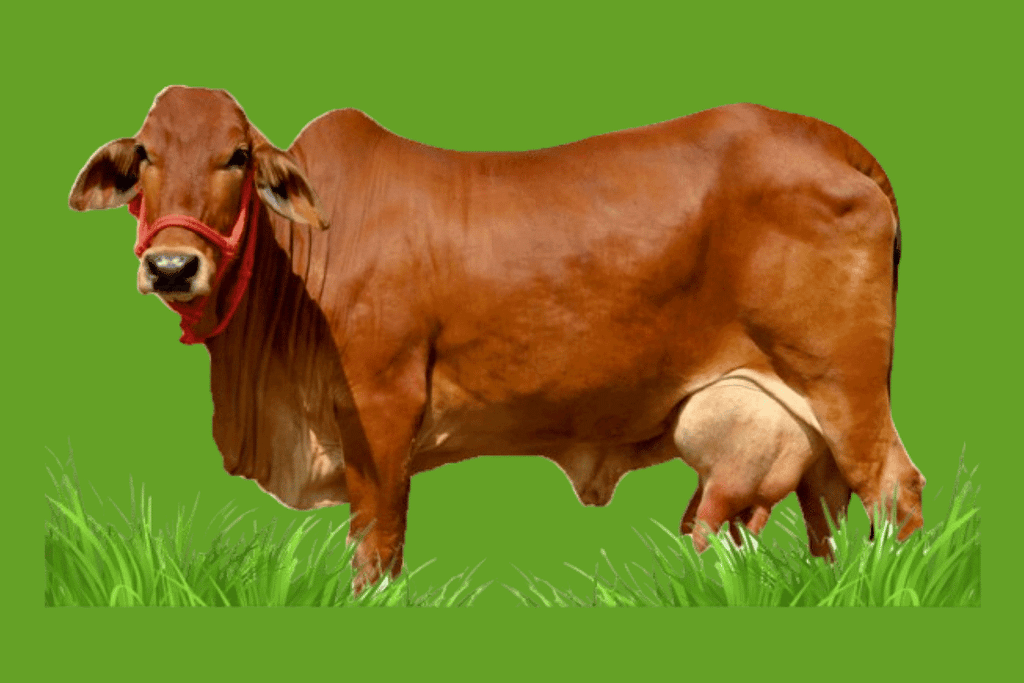Are You a Potential Buyer Of a Sahiwal Cow? If Yes, This Article Is Very Important For You. In The Market, Informed Buyer Always Win, So Get Informed Properly about Sahiwal cows Before Purchasing One. This article talks about the Sahiwal cow, covering its price, how much milk it gives daily, what it eats, how well it adapts to different places, its size, and where it comes from.
If you’re a farmer or interested in cows, this info helps you plan your farm, choose the right cow, and understand how to take care of it. Learning about the Sahiwal cow’s history also helps you make smart decisions. In simple terms, this short guide gives useful info for farmers, investors, or anyone curious about raising Sahiwal cows and making the most of their abilities on the farm.
Read Also: Gir Cow Price, Milk Per Day, Images, Food, Adaptability, And Dimensions
Introduction Of Sahiwal Cow

The Sahiwal cow is a special kind of cow that comes from the Sahiwal area in India and Pakistan. It’s a type of zebu cattle. People really like this cow because it has unique features, and they mostly use it for making milk. Let me tell you more about the Sahiwal cow:
Physical Characteristics:
Colour: The Sahiwal cow is usually red or reddish-brown, with a short coat of fine and dense hair. Some individuals may have white markings on the face, legs, and the underside of the body.
Build: It has a medium to large-sized body with a well-developed hump over the shoulders, which is a typical feature of zebu cattle. The hump stores energy and nutrients, allowing the cow to withstand periods of food scarcity.
Head: The head is medium-sized with a broad forehead and well-developed horns that curve upward and slightly backward. The ears are medium-sized and drooping.
Adaptability:
Climate Resistance: Sahiwal cows are well-adapted to hot and humid climates, making them suitable for regions with high temperatures. They are resistant to various diseases and parasites commonly found in tropical environments.
Drought Resistance: These cows are known for their ability to withstand periods of drought and scarcity of quality forage, making them valuable in areas with erratic rainfall.
Dairy Characteristics:
Milk Production: Sahiwal cows are renowned for their high milk yield, producing milk with relatively high-fat content. They are considered one of the best dairy breeds among zebu cattle.
Quality of Milk: The milk from Sahiwal cows is rich in nutrients, including proteins and fats. This makes it suitable for the production of various dairy products.
Cultural and Economic Importance:
Cultural Significance: The Sahiwal cow holds cultural significance in the regions where it is prevalent. It is often associated with traditional agricultural practices and integral to the rural economy.
Economic Impact: Due to its high milk production, the Sahiwal cow contributes significantly to farmers’ livelihoods in the form of dairy products and, in some cases, as a source of income through the sale of surplus milk or calves.
The Sahiwal cow is a tough and strong type of cow. It’s good at handling tough weather and can live in difficult conditions. One special thing about this cow is that it’s good at making a lot of milk. Because of this, farmers in warm areas find it very useful for making dairy products. The Sahiwal cow is a valuable helper for dairy farming in hot places.
Related Content: Mini Highland Cow: Lifespan, Size, Weight, Price, Care Tips 2024
Sahiwal Cow Price And Cost
Sahiwal cows are really good for making milk, and their prices can be different. Some cost around 60,000 INR, while others can be as much as 800,000 INR. It depends on how old they are, if they’re healthy, and how much milk they can make. People like these cows because they come from Sahiwal in Pakistan and are great at making high-quality milk.
In dollars, the price range is about $800 to $10,600. The cost changes because each cow is different, considering things like family, how much milk they made before, and how healthy they are. Farmers pick Sahiwal cows because they are tough and can make a lot of good milk, making them a good choice for anyone who wants a good cow for their farm.
Sahiwal Cow Origin And History
The Sahiwal cow comes from Sahiwal, Pakistan, and it’s famous for making a lot of good milk. People started developing this breed by mixing local cows with high-yielding ones. They did this to get cows that produce more milk and can live in different weather conditions.
Sahiwal cows have a special reddish-brown coat and a strong body. They’re known for being able to resist diseases, handle heat well, and eat efficiently. These cows give high-quality milk with the right amount of fat and protein. Farmers all over like them because they’re great for dairy farming, helping farmers and the dairy industry grow.
So, Sahiwal cows have a cool history of people carefully choosing and breeding them to be tough, healthy, and awesome at making milk.
Related Content: Punganur Cow Price, Daily Milk Yield, Life Span, Feed, and Size Discussed!
How Much Sahiwal Cow Produce Milk Per Day?

The milk production of Sahiwal cows can vary depending on factors such as age, health, diet, and overall care. On average, a healthy Sahiwal cow is capable of producing around 8 to 12 litres of milk per day. However, some high-yielding Sahiwal cows can even exceed this range and produce more milk.
It’s important to note that proper nutrition, good management practices, and a comfortable environment contribute to the optimal milk production of any dairy cow, including Sahiwal cows.
Farmers usually focus on providing balanced feed, ensuring access to clean water, and maintaining a stress-free environment to maximize the milk output from their Sahiwal cows. Factors like the stage of lactation and breeding status also influence daily milk production.
Dimension And Characteristic Of Sahiwal Cow
The Sahiwal cow, hailing from the Sahiwal district in Pakistan, stands out for its distinctive features that make it an ideal choice for dairy farming. Let’s delve into its key attributes:
1. Size and Structure:
Sahiwal cows are characterized by a medium to large size, showcasing a robust and well-developed frame. Their straight back and broad chest contribute to their sturdy build.
2. Color and Coat:
Sporting a reddish-brown coat that is short and fine, Sahiwal cows exhibit varying shades of red, ranging from light to dark.
3. Head and Horns:
With a moderately sized head boasting a broad forehead, Sahiwal cows possess medium to large horns that may gently curve outward. Their medium-sized, drooping ears add to their distinctive appearance.
4. Udder and Teats:
Sahiwal cows feature a well-developed udder with good capacity, accompanied by evenly placed and medium-length teats. This udder structure facilitates efficient and easy milking.
5. Adaptability:
Notably, Sahiwal cows showcase remarkable adaptability to diverse climates. Thriving in hot and humid conditions, they prove suitable for various regions, making them resilient to environmental challenges.
6. Milk Production:
Renowned for their excellent milk production, Sahiwal cows deliver high-quality milk. On average, they yield between 8 and 12 litres per day, with some individuals surpassing this range. This makes them a preferred choice for dairy farmers seeking reliable milk producers.
7. Disease Resistance:
Sahiwal cows exhibit a commendable level of resistance to common diseases, underscoring their overall hardiness and durability in varying agricultural conditions.
In essence, the combination of these characteristics positions Sahiwal cows as a favoured breed for dairy farmers aiming for both resilience and productivity in their herds.
Best Food For Sahiwal Cow
Feeding Sahiwal cows a balanced and nutritious diet is crucial for their overall health, milk production, and reproductive success. Here are the key components of an optimal diet for Sahiwal cows:
High-Quality Forage:
Provide good-quality forage such as green fodder, legume hay, or silage. Forage is a primary source of fibre, essential for proper digestion and maintaining rumen health.
Concentrates:
Supplement the forage with concentrates like grains (corn, barley, oats) and protein-rich feeds (soybean meal, sunflower meal). Concentrates provide energy and protein necessary for milk production.
Minerals and Vitamins:
Ensure access to a balanced mineral mix containing essential minerals like calcium, phosphorus, magnesium, and vitamins. This is vital for bone health, reproduction, and overall metabolic functions.
Clean and Fresh Water:
Always give your Sahiwal cow plenty of clean and fresh water. Water is really important because it helps with digestion, absorbs nutrients, and keeps your cow hydrated overall. Make sure there’s water available all the time so your cow stays healthy and happy.
Salt:
Remember to add some salt to your Sahiwal cow’s food. Salt is important because it helps your cow balance fluids and supports the nerves. It makes sure everything works well inside your cow’s body. Just a little bit of salt supplement in their diet is good to keep them healthy and feeling good.
Green Fodder and Legumes:
Incorporate green fodder and legumes into the diet to enhance the protein content. Legumes like alfalfa are rich in protein and can contribute to improved milk production.
Maintain Feeding Schedule:
Establish a consistent feeding schedule to help Sahiwal cows adapt to a routine. Regular feeding times contribute to better digestion and nutrient utilization.
Avoid Spoiled or Contaminated Feed:
Ensure that the feed provided is fresh and free from mould or contaminants. Contaminated feed can lead to health issues and a decline in milk production.
Monitoring Body Condition:
Regularly monitor the body condition of Sahiwal cows and adjust the diet accordingly. This helps in preventing overfeeding or underfeeding, ensuring optimal health and productivity.
Consult with a Nutritionist:
For a tailored feeding program, consult with a livestock nutritionist who can analyze the specific needs of your Sahiwal cows based on factors like age, weight, and lactation status.
Conclusion
Frequently Asked Questions
What Is the Price of Sahiwal Cow Milk?
Savour the goodness of health with Sahiwal cow milk, a nourishing elixir that thrives in rural landscapes. Delight in the purity of each litre as Sahiwal cow milk graces the markets in rural kingdoms at an affordable 80 INR. For urban fans, the price escalates to a range of 100 INR to 110 INR per litre, reflecting the premium on this wholesome and coveted dairy treasure.
Which Cow Gives the Highest Milk?
The Holstein cow holds the crown for producing the highest quantity of milk. Known for its prolific milk production, this breed is widely recognized in the dairy industry for its efficiency.
What Is the Price of a Red Sindhi Cow?
According to TradeIndia, the price for a Red Sindhi cow is 40,000.00 INR per piece. This rate includes the applicable Goods and Services Tax (GST) at 0%. The Cow has an associated weight of 325.00 kilograms, and each pack consists of one Cow. The minimum pack size available is one. It’s important to note that prices can still vary based on individual factors such as age, health, and other specific attributes of the Cow.
Which Cow Is the Most Expensive?
The title of the most expensive Cow is often subjective and depends on factors like breed, pedigree, and market demand. Breeds like Jersey, Holstein, or Wagyu may command higher prices due to their specific characteristics.
Which Is the Indian Expensive Cow?
Determining the most expensive Cow in India can be context-dependent. Various indigenous breeds, such as Gir or Red Sindhi, may be valued for their unique traits, contributing to higher prices in certain regions.
How Much Does a Baby Cow Cost?
The cost of a baby cow, also known as a calf, varies based on factors like breed, age, and health. On average, prices can range from a few hundred to a few thousand INR. Consulting local breeders or livestock markets will provide more specific and current pricing information.










[…] Sahiwal cow is known for its high milk production and is valued for its ability to produce large quantities of milk with high butterfat […]